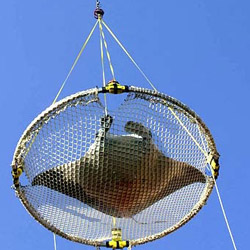|
The Peppermint Shrimp is best known for its natural ability to manage nuisance Aiptasia, or glass anemones. Keep in mind that some individual Peppermint Shrimp are better at managing aiptasia while others may not be interested in aiptasia at all. Though considered part of the “cleaner” grouping of shrimp, Lysmata wurdemanni is more of a scavenger. The Peppermint Shrimp picks its way around your aquarium and live rock to consume detritus, uneaten food, and decomposing organic material. This ornamental member of the Hippolytidae family is brightly colored with a creamy white body striped with several thin and distinct longitudinal red bands. The Peppermint Shrimp is very social and peaceful towards most reef inhabitants. Like other invertebrates, the Peppermint Shrimp cannot tolerate copper-based medications or high nitrate levels. It also requires supplemental iodine to encourage proper molting of its carapace. In addition to what it obtains from scavenging, the diet of the Peppermint Shrimp should consist of most types of prepared foods and the occasional pieces of fresh fish. The Peppermint Shrimp species has been successfully bred by commercial fish farms, but it will rarely breed in the average home aquarium. Quick Stats:  Note: This profile is currently incomplete. Description and/or images are temporarily taken from LiveAquaria and will be replaced shortly. If you are interested in writing a new description, please contact me at info@myfishtank.net. If you have any experience with this particular fish, please leave a comment below and share with us. Note: This profile is currently incomplete. Description and/or images are temporarily taken from LiveAquaria and will be replaced shortly. If you are interested in writing a new description, please contact me at info@myfishtank.net. If you have any experience with this particular fish, please leave a comment below and share with us. |





{ 0 comments… add one now }